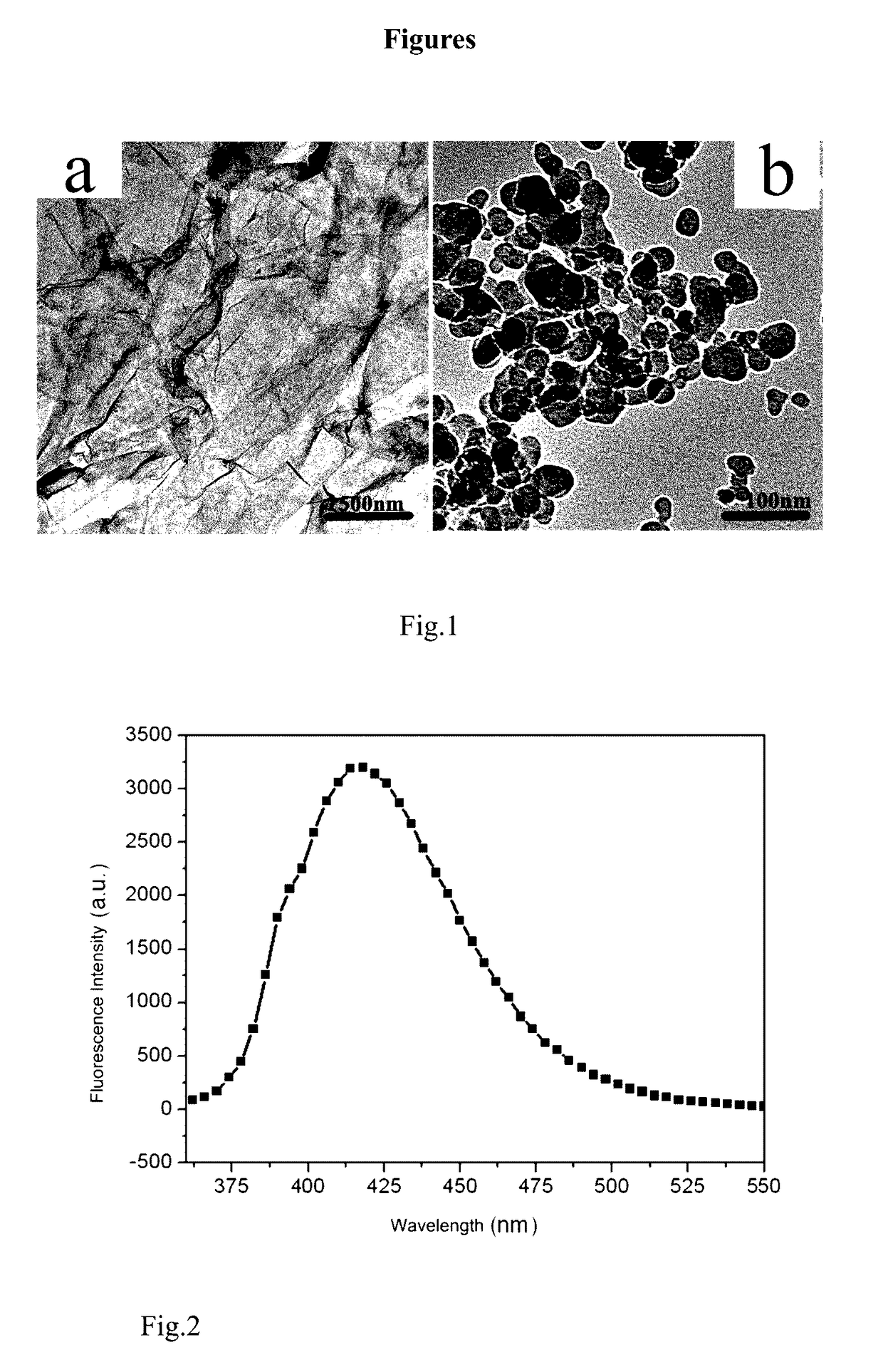Method for preparation of carbon quantum dots and application
a carbon quantum and radical technology, applied in the field of catalytic nanomaterials, can solve the problems of inability to prepare quantum dots using radicals produced by metal-free catalysis, limited large-scale production and application of cqds, and difficult separation of graphene quantum dots of smaller size, etc., to achieve good dispersibility and easy separation
- Summary
- Abstract
- Description
- Claims
- Application Information
AI Technical Summary
Benefits of technology
Problems solved by technology
Method used
Image
Examples
example 1
[0060](1) Graphite oxide was prepared by a modified Hummers method. 1.5 mg / mL of graphite oxide solution (GO) was treated in water by ultrasonic wave for 1 h with an ultrasonic power of 50 W, to form a homogeneous dispersion;
[0061](2) Tetrachlorobenzoquinone was dissolved in 5% ethanol solution. The tetrachlorobenzoquinone solution was added dropwise to the dispersion obtained in step (1), with the concentration ratio of tetrachlorobenzoquinone to graphene being 3:1. The pH of the solution was adjusted to be 7 using NaOH. Then grafting was carried out by using ultrasonic wave for 2 h. And thereby, a dispersion of graphene oxide-halogenated quinone composite material was obtained;
[0062](3) H2O2 solution was added to the solution obtained in step (2), wherein the concentration ratio of H2O2 to tetrachlorobenzoquinone was 10:1, and the system was then stirred in a water bath at 25° C. for 0.5 h;
[0063](4) The solution obtained after the reaction in step (3) was filtered using polytetraf...
example 2
[0068](1) 2 mg / mL of graphene solution was treated in water by ultrasonic wave for 1.5 h at an ultrasonic power of 50 W, to form a homogeneous dispersion;
[0069](2) 2,5-dichloro-1,4-benzoquinone was dissolved in 3% acetonitrile solution. The 2,5-dichloro-1,4-benzoquinone solution was added dropwise to the dispersion obtained in step (1), with the concentration ratio of 2,5-dichloro-1,4-benzoquinone to graphene being 2:1. The pH of the solution was adjusted to be 7 using NaOH. Then grafting was carried out by using ultrasonic wave for 2 h. And thereby, a dispersion of graphene oxide-halogenated quinone composite material was obtained;
[0070](3) H2O2 was added to the solution obtained in step (2), wherein the concentration ratio of H2O2 to 2,5-dichloro-1,4-benzoquinone was 5:1, and the system was then stirred in a water bath at 25° C. for 1 h;
[0071](4) The solution obtained after the reaction in step (3) was filtered using polytetrafluoroethylene filtration membrane, and the filtrate co...
example 3
[0074](1) 1 mg / mL of carbon nanotube solution was treated in water by ultrasonic wave for 1 h at an ultrasonic power of 60 W, to form a homogeneous dispersion;
[0075](2) Tetrabromobenzoquinone was dissolved in 5% ethanol solution. The tetrabromobenzoquinone solution was added dropwise to the dispersion obtained in step (1), with the concentration ratio of tetrabromobenzoquinone to carbon nanotube being 2:1. The pH of the solution was adjusted to be 7 using NaOH. Then grafting was carried out by using ultrasonic wave for 2 h. And thereby, a dispersion of carbon nanotube-halogenated quinone composite material was obtained;
[0076](3) H2O2 was added to the solution obtained in step (2), wherein the concentration ratio of H2O2 to tetrabromobenzoquinone was 8:1, and the system was then stirred in a water bath at 25° C. for 0.5 h;
[0077](4) The solution obtained after the reaction in step (3) was filtered using polytetrafluoroethylene filtration membrane, and the filtrate continued to be stir...
PUM
 Login to View More
Login to View More Abstract
Description
Claims
Application Information
 Login to View More
Login to View More - R&D
- Intellectual Property
- Life Sciences
- Materials
- Tech Scout
- Unparalleled Data Quality
- Higher Quality Content
- 60% Fewer Hallucinations
Browse by: Latest US Patents, China's latest patents, Technical Efficacy Thesaurus, Application Domain, Technology Topic, Popular Technical Reports.
© 2025 PatSnap. All rights reserved.Legal|Privacy policy|Modern Slavery Act Transparency Statement|Sitemap|About US| Contact US: help@patsnap.com

